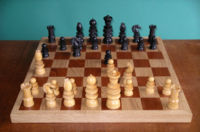Ebony
2007 Schools Wikipedia Selection. Related subjects: Plants
| iEbony | ||||||||||||||
|---|---|---|---|---|---|---|---|---|---|---|---|---|---|---|
| Scientific classification | ||||||||||||||
|
||||||||||||||
|
|
||||||||||||||
| Diospyros ebenum Koenig ex Retz. |

Ebony (Diospyros ebenum), also known as Indian Ebony or Ceylon Ebony, is a tree in the genus Diospyros, native to southern India and Sri Lanka. It is noted for its heavy, (initially) black, fine-grained heartwood. It is a medium-sized evergreen tree, reaching 20–25 m tall. The leaves are entire, about 6–15 cm long and 3–5 cm broad. The fruit is a small berry 2 cm diameter, similar to a small persimmon. Although the wood and heartwood of the tree appear black when first harvested, typically within six months to one year the grain lightens to a chocolate-colored brown. To prevent this, the wood is treated with a stain that causes it to retain its original (and expected) black colour.
Uses
Ebony heartwood is one of the most intensely black woods known, which, combined with its very high density (it is one of the very few woods that sinks in water), fine texture, and ability to polish very smoothly, has made it very valuable as an ornamental wood. It has a long history of use, with carved pieces having been found in Ancient Egyptian tombs. The word "ebony" derives from the Ancient Egyptian hbny, via the Greek έβενος (ebenos), by way of Latin and Middle English.
By the end of the 16th century, fine cabinets for the luxury trade were made of ebony in Antwerp. The dense hardness lent itself to refined moldings framing finely detailed pictorial panels with carving in very low relief ( bas-relief), usually of allegorical subjects, or taken from classical or Christian history. Within a short time, such cabinets were also being made at Paris, where their makers became known as ébénistes, which remains the French term for a cabinetmaker.
Modern uses are largely restricted to small sizes, particularly in musical instrument making, including piano and harpsichord keys, violin, guitar, and cello finger boards, pegs and chinrests. Traditionally, black piano and harpsichord keys were ebony, and the black pieces in chess were made from ebony, with holly wood (of similar texture, but white) being used for the white pieces. Modern East Midlands-style lacemaking bobbins, also being small, are often made of ebony and look particularly decorative when bound with brass or silver wire.
As a result of unsustainable harvesting, many species of ebony are now considered threatened (compare the recommendations found under the IUCN Red List http://www.redlist.org with those species accepted as endangered and for which import restrictions apply at http://www.cites.org ).

